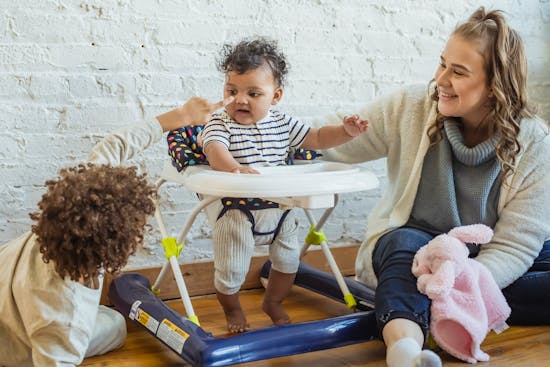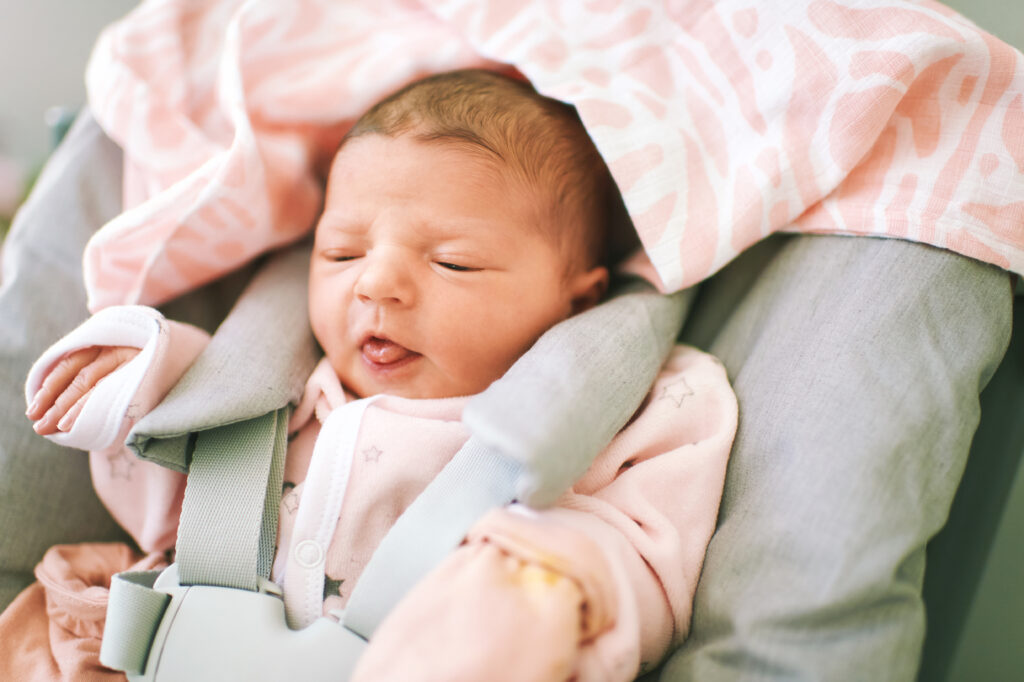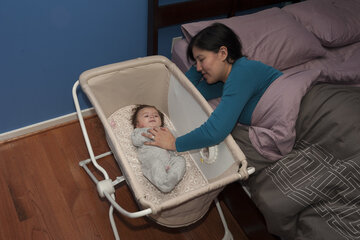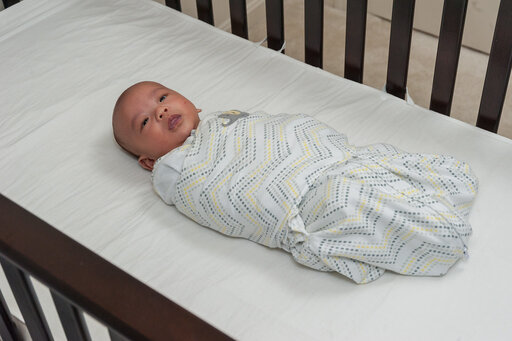
Are you wondering when it’s safe to introduce a walker to your baby? While baby walkers are a popular tool to help your little one develop mobility, it’s important to understand the right time and the safety considerations involved.
Typically, babies can start using a walker when they can sit up on their own and have developed the strength to support their weight. This usually happens around 6 to 9 months of age, but every baby is different.
Before introducing a walker, make sure your baby is ready for this type of support and ensure it aligns with their developmental milestones.
While baby walkers can offer fun and excitement for babies, it’s crucial to keep in mind potential safety concerns. Walkers can increase the risk of falls, and babies might not have full control of their movements.
It’s essential to supervise your baby at all times when using a walker and ensure that the environment is safe, free of obstacles, and fully baby-proofed.
This guide provides insight into when to start using a walker, its benefits, and the precautions to consider, helping you make an informed decision for your baby’s growth and safety.
When Can a Baby Use a Walker?
The right time for a baby to start using a walker depends on their individual physical development and readiness. Typically, most babies may begin using a walker between 4 and 16 months of age. Key milestones indicating readiness include:
The ability to hold their head up steadily.
Sitting upright without support.
Showing some leg strength to push off the ground.
Do Walkers Help Babies Learn to Walk?
Contrary to popular belief, baby walkers do not help babies learn to walk. Studies suggest that excessive use of walkers can delay walking milestones because they allow mobility without the baby strengthening key muscles needed
for independent walking. Instead, activities like supervised tummy time and free movement on the floor are much more beneficial for developing motor skills.
Age Range for Using a Baby Walker
Most babies can start using a walker between 4 and 16 months, depending on their developmental milestones. Babies are generally ready for a walker when they:
4–6 months: Begin holding their head up steadily.
6–8 months: Can sit upright without support.
8–12 months: Show sufficient leg strength to push off the floor.
However, not all babies develop at the same pace, and some may reach these milestones earlier or later than others. Always assess your baby’s readiness before introducing a walker and consult with a pediatrician if you’re unsure.
Baby’s Feet and Walker Use
When using a baby walker, it’s important to ensure your baby’s feet are positioned correctly for safe and comfortable movement. The baby’s feet should touch the floor flatly, not just their toes, to allow proper pushing and avoid straining their legs or feet.
If a baby’s feet dangle or only their toes make contact with the ground, it could lead to improper posture or discomfort. Adjust the walker’s height so your baby can comfortably stand with their knees slightly bent and feet flat.
Key Points to Remember
Feet Flat on the Floor: This ensures proper balance and avoids undue strain on your baby’s legs and feet.
Height Adjustment: Check that the walker is at the right height for your baby’s size.
Natural Development: Over-reliance on walkers may hinder natural foot and leg muscle development, so balance its use with floor play and other activities.
Physical Readiness for a Baby Walker
Introducing a baby walker requires careful consideration of your baby’s physical development to ensure safety and prevent strain.
Babies should meet specific milestones to demonstrate that they are ready to use a walker. Here’s what to look for:
Key Signs of Physical Readiness
Sitting Unassisted:
A baby should be able to sit upright without leaning or wobbling, which indicates adequate core strength to maintain stability in a walker. This typically happens between 6–8 months.
Leg Strength:
Your baby should show the ability to push with their legs against the floor. This helps them propel the walker forward without overexertion or discomfort.
Weight-Bearing Ability:
Babies should be comfortable putting some weight on their legs when standing with support. This demonstrates that their bones and muscles are ready for light resistance.
Coordination:
Babies need some level of coordination to control their movements, such as being able to turn their heads to look around and respond to their surroundings.
When Can a Baby Use a Push Walker?

Push walkers are an exciting tool that can assist babies in developing their walking skills, but like any developmental tool, timing is crucial for safety and effectiveness.
The best time for a baby to use a push walker depends on their physical readiness, coordination, and overall development. Here’s a guide to when a baby can start using a push walker and what factors to consider:
Ideal Age for Using a Push Walker
Most experts recommend introducing a push walker when a baby is between 9 to 12 months old, although the exact timing can vary depending on the baby’s individual development. The key factors to consider include:
Ability to Stand with Support (8-10 months)
Before using a push walker, babies should be able to stand up with support, such as holding onto furniture or an adult’s hand.
This typically happens between 8 to 10 months. Standing with support is important because a push walker requires the baby to support their weight while pushing it.
Good Balance and Coordination (9-12 months)
Babies should have developed the ability to balance themselves in a standing position, which generally occurs between 9 to 12 months. If a baby can hold their weight on their legs and balance while standing with support,
they are ready to use a push walker. At this stage, they are also likely starting to practice walking by holding onto furniture or other objects.
Strong Leg Muscles (9-12 months)
Push walkers help babies practice walking, but babies need strong leg muscles to move the walker forward. Most babies have the necessary strength in their legs by the time they are 9 to 12 months old.
The push walker allows them to refine their walking movements by providing something stable to hold onto as they take their first steps.
Why the Right Age Matters
Using a push walker too early can increase the risk of accidents or hinder proper development. For example:
Premature Use: If a baby isn’t ready to support their weight or balance, a push walker might lead to falls or other injuries.
Underdeveloped Leg Muscles: Babies who haven’t developed sufficient strength in their legs might not be able to properly push the walker, leading to frustration or possible strain on developing muscles.
Delayed Milestones: If a baby isn’t encouraged to crawl or cruise (walk while holding onto furniture) before using a push walker, it could delay the development of important motor skills and coordination.
Stages of a Baby Learning to Walk

Each stage of development builds on the last, with key milestones that show a baby’s growing physical and motor skills. This journey is unique for each baby, with some taking their first steps earlier than others, while some might need more time.
Below, we will explore the stages in more detail, highlighting what to expect and how parents can support their babies along the way.
Tummy Time (0-6 months)
Tummy time is one of the earliest and most important activities for babies. It may seem like a simple exercise, but it lays the groundwork for many motor skills, including the ability to sit, crawl, and eventually walk.
Developmental Focus:
Lifting the head and chest off the ground.
Strengthening the core and arm muscles.
Developing coordination between arms and legs.
Why It Matters for Walking:
Tummy time promotes upper body strength, which is essential for sitting, crawling, and standing. Babies who spend ample time on
their tummy will have the muscle strength and coordination needed for later developmental stages. Without tummy time, babies may experience delays in motor skills, such as crawling and standing.
Sitting Unassisted (6-8 months)
Once babies can sit up independently, they develop better control over their bodies and improve their balance. Sitting unassisted requires babies to develop strong core muscles, which will be crucial when they transition to crawling and later, standing.
Developmental Focus:
Strengthening the back and abdominal muscles.
Improving balance and stability.
Reaching for and interacting with objects while sitting.
Why It Matters for Walking:
Sitting up without support helps babies strengthen the muscles needed for standing and walking. It also helps them develop the spatial awareness needed for balance, a key factor when they begin to stand and walk.
How Parents Can Support This Stage:
Offer toys that encourage reaching and twisting to engage the core muscles.
Provide pillows or cushions around the baby for safety as they practice sitting.
Use playtime as an opportunity to engage the baby and encourage them to sit and play on their own.
Sitting Unassisted (6-8 months)
Sitting unassisted marks the development of core strength and balance. When babies can sit up independently, it helps them build control over their bodies, which is essential for future movement.
Developmental Focus: Core strength, balance, and coordination.
Why It Matters for Walking: Sitting allows babies to develop a sense of balance and body awareness, which helps them stand and move later on.
How Parents Can Support This Stage:
Offer toys that encourage reaching and twisting while seated to further develop trunk rotation and balance.
Provide pillows or cushions to create a safe environment as the baby practices sitting.
Pulling Up to Stand (8-12 months)
Once babies have sufficient strength and balance, they begin pulling themselves up to a standing position using furniture, such as sofas or tables. This stage helps babies learn to shift weight from one leg to another and practice standing.
Developmental Focus: Leg and core strength, balance, and stability.
Why It Matters for Walking: Pulling up helps babies learn to bear weight on their legs and supports the development of balance, which are essential skills for walking.
How Parents Can Support This Stage:
Provide sturdy furniture or support for the baby to pull up on.
Be ready to catch them, as they may be wobbly or unsteady in this stage.
Cruising (9-13 months)
Cruising is when babies begin to move around while holding onto furniture or other objects. It encourages babies to practice shifting their weight from one foot to the other and helps develop leg strength and coordination.
Developmental Focus: Balance, leg strength, weight shifting, and coordination.
Why It Matters for Walking: Cruising builds confidence, improves balance, and strengthens muscles that are necessary for walking independently.
How Parents Can Support This Stage:
Arrange furniture to create a safe, spacious environment for cruising.
Encourage cruising by placing toys or objects along the furniture that invite movement.
First Independent Steps (9-18 months)
The first independent steps are often taken between 9 and 18 months, though some babies may take them earlier or later. These steps are usually wobbly and uncoordinated at first.
Developmental Focus: Leg strength, balance, coordination, and motor control.
Why It Matters for Walking: Taking independent steps marks a significant achievement in motor development, showcasing the baby’s ability to balance and move without support.
How Parents Can Support This Stage:
Encourage independent walking by holding their hands for a few seconds or offering support when needed.
Let the baby practice walking on soft, safe surfaces.
Use supportive footwear or go barefoot to help babies feel stable while walking.
Walking Confidently (12-18 months)
After the first few steps, babies become more confident and steady on their feet. This stage involves walking longer distances and gradually improving coordination and balance.
Developmental Focus: Gait, coordination, and posture.
Why It Matters for Walking: As babies walk more confidently, they refine their skills and can start to engage in other physical activities, such as running, kicking, and climbing.
The Best Age to Use a Baby Walker

When it comes to baby walkers, there is no one-size-fits-all answer, as the best age for using a walker depends on a baby’s developmental readiness and individual milestones.
While baby walkers can be a fun and engaging tool for babies, they should be used with caution and at the right time to ensure safety and proper development.
Below is an in-depth look at the best age for introducing a baby walker, along with important considerations for safe use.
Developmental Readiness for Baby Walkers
A baby walker is designed to help babies move around by providing support and mobility when they cannot walk independently. However, babies need to have reached specific developmental milestones before a walker can be safely used.
Key Developmental Milestones for Using a Walker:
Head and Neck Control: Before using a walker, babies should be able to hold their head steady and have strong neck muscles, which typically happens around 4 to 6 months of age. Without this ability, babies might have difficulty balancing in the walker.
Sitting Up Independently: Babies should also be able to sit up on their own before using a walker, which usually occurs around 6 to 8 months. Sitting unassisted helps develop the core muscles necessary for balance when using a walker.
Leg Strength and Weight Bearing: Babies need to have sufficient leg strength to support their body weight and bear weight on their legs.
This typically occurs around 8 to 10 months. A baby who is not yet capable of standing or bearing weight may be too young to use a walker safely.
Motor Skills and Coordination: Babies should be developing basic coordination and be able to push themselves forward with their legs. These motor skills usually begin to develop around 9 to 12 months.
Ideal Age for Introducing a When Can Baby Use Walker
Most experts recommend introducing a baby walker around 9 to 12 months of age. At this stage, babies are likely to have reached the necessary developmental milestones, such as sitting up, supporting their weight on their legs, and improving coordination.
Why 9 to 12 Months Is the Ideal Age:
At this age, babies are becoming more mobile and curious about their environment, so a walker can help them explore safely.
The walker can help strengthen the baby’s leg muscles and give them practice with walking motions, though it should not be relied upon as a tool to teach walking.
Babies in this age range are better equipped to control their movements, making the walker a fun tool for exploring their surroundings.
Benefits of Using a Baby Walker

While baby walkers are a controversial topic, they can offer certain benefits when used properly and at the right developmental stage. When a baby is ready for a walker and it’s used safely,
it can help with physical development, provide entertainment, and encourage exploration. Here’s a closer look at the benefits of using a baby walker:
Promotes Mobility and Exploration
A baby walker gives babies the freedom to explore their environment, especially when they are not yet walking independently.
By providing support and allowing babies to move around, walkers can help them engage with their surroundings in new and exciting ways.
Developmental Benefit:
The walker encourages babies to explore areas that they may not be able to reach by crawling alone. This can stimulate their curiosity, helping them learn more about their environment and how to interact with different objects.
Why It Matters:
Mobility is an essential part of a baby’s development. It helps improve their spatial awareness, and exploring new areas helps babies build confidence
in their movements. A walker gives them a new perspective on their world, making them more eager to learn and grow.
Strengthens Leg Muscles
One of the primary benefits of a walker is that it helps strengthen a baby’s legs, particularly the muscles needed for standing and walking.
As babies use the walker, they press their feet down and push off with their legs, which engages key muscles in their thighs, calves, and core.
Developmental Benefit:
The action of standing and moving in the walker strengthens the muscles that are crucial for walking. While the walker doesn’t teach babies how to walk independently, it provides practice in weight-bearing and helps with leg muscle development.
Why It Matters:
Leg strength is necessary for taking independent steps and for balancing while walking. The more a baby’s muscles are strengthened, the more likely
they will be able to walk on their own when the time comes. The walker provides a controlled, low-risk environment to work on leg strength.
Risks and Safety Concerns of Baby Walkers

While baby walkers can provide benefits such as promoting mobility and encouraging leg strength, they also come with several risks and safety concerns that parents should be aware of.
Understanding these risks can help ensure that walkers are used safely, protecting babies from accidents or developmental setbacks. Below is an overview of the key risks and safety concerns associated with baby walkers.
Increased Risk of Falls
One of the most significant risks associated with baby walkers is the increased likelihood of falls. Babies can move faster than they can control, which increases the risk of tipping over or falling down stairs.
Why It’s Dangerous:
Baby walkers can give babies the illusion of independence and mobility, but they may not have the balance or coordination to avoid obstacles. A walker can also cause babies to fall over suddenly or tip over when they lean too far forward or sideways.
Safety Tip:
Always supervise your baby when using a walker. Never leave them unattended, even for a few seconds. Ensure that the area is free from stairs or sharp objects, and use baby gates to block stairways.
Falling Down Stairs
Baby walkers can be especially dangerous if babies come into contact with stairs. Many walkers are equipped with wheels that allow babies to move quickly, increasing the risk of falling down stairs or steps.
Why It’s Dangerous:
If a baby in a walker rolls toward stairs or an elevated area, they may not be able to stop in time. This can result in serious injuries, including head trauma, broken bones, or other significant harm.
Safety Tip:
Always make sure that the area where your baby is using the walker is free of stairs or elevated surfaces. Install baby gates at the top and bottom of stairs to prevent access to these dangerous areas.
Lack of Control Over Speed and Direction
Some walkers have wheels that make it easy for babies to zoom around, which can lead to a lack of control. Fast movement can make it harder for babies to stop, and they may accidentally crash into furniture or walls.
Why It’s Dangerous:
If the walker moves too quickly, the baby may struggle to regain control or stop. This can increase the risk of falls, bumps, and bruises. The walker may also move faster on slippery surfaces, making it harder for the baby to stay upright.
Improper Posture or Alignment
Some baby walkers can encourage poor posture or improper alignment as babies rely on them for support. This can lead to long-term posture problems, particularly if the walker encourages the baby to lean too far forward or backward.
Why It’s Dangerous:
If the walker doesn’t support the baby’s body correctly or encourage them to lean forward, it can negatively affect their spinal alignment and muscle development.
Concerns with Baby Walkers
These concerns range from safety issues to developmental considerations. Below, we explore the main concerns associated with baby walkers to help parents make informed decisions about whether or not to use them.
Increased Risk of Accidents and Injuries
One of the most significant concerns with baby walkers is the increased risk of accidents and injuries. As babies gain mobility in the walker, they often become more adventurous, which can lead to dangerous situations.
Collisions with Furniture or Objects: Babies using walkers can crash into furniture, corners, or sharp objects, which can cause bruises, cuts, or even more severe injuries.
Lack of Control: Babies in walkers often don’t have the coordination to control their movement fully, which can result in crashes or falls.
Delayed Developmental Milestones
Many experts have raised concerns that overuse of baby walkers can delay important developmental milestones, particularly with physical movement.
Babies who use walkers might miss opportunities for key developmental activities like crawling, standing with support, and cruising (moving while holding onto furniture).
Crawling Delay: Crawling is an essential developmental milestone that helps babies strengthen their muscles and develop coordination.
If babies spend too much time in a walker, they might skip crawling or delay it, which can interfere with their motor development.
Balance and Coordination Issues: Baby walkers may give babies the false impression that they can walk on their own before they’re ready.
This can delay their ability to balance and coordinate their body independently, which are key skills for learning to walk.
Conclusion
When Can Baby Use Walker may seem like a convenient and fun tool for helping babies explore their surroundings and develop leg strength, they come with several risks and concerns that should not be overlooked.
From safety hazards such as falls and collisions to the potential delay in motor development and muscle strengthening, the use of baby walkers requires careful consideration.
Experts recommend that parents ensure their babies are developmentally ready for walkers—able to support their weight and demonstrate proper balance—before introducing them.
Walkers should be used with extreme caution and always under supervision, in a safe and obstacle-free environment.
It is essential to remember that baby walkers should not replace other forms of physical development like crawling, cruising, or standing with support, which are all critical steps in helping babies build strength, coordination, and balance.


Leave a Comment